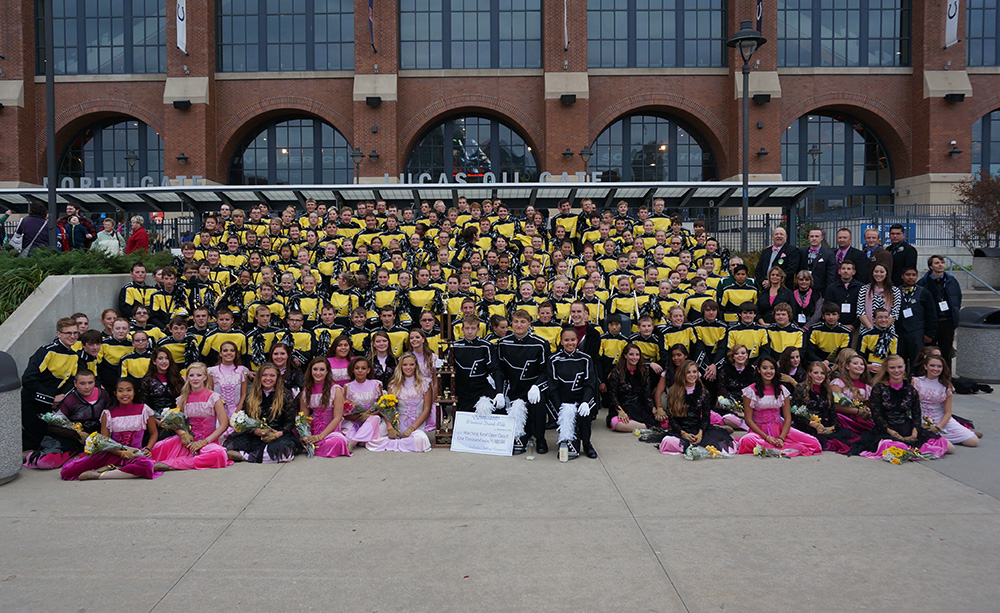Marching season is a whirlwind of events. It can also be a little confusing, even for veteran band parents. So, as a public service announcement, here’s a breakdown of events, classes, etc.
Let’s start with classes.
Greenwood competes on the ISSMA Open Class circuit. This is the competitive circuit for seasoned Indiana bands. Open Class bands are divided into four groups, A, B, C and D. These classes are not a judgement of quality or a measure of the band’s size. The Open Class designations are based on school enrollment for grades 9-12. Class D schools have up to 569 students. Class C schools have 570 – 946. Class B schools have 947 – 1,659. Class A schools have 1,660 and over. These population splits are adjusted annually by ISSMA to keep a balance within the classes and take school population changes into account.
ISSMA also has Festival and Scholastic classes. Festival Class is for bands looking for an assessment of their program without the competitive component. The Scholastic Class is a relatively new class for developing programs. You may see a Scholastic competition prior to Open class at an Invitational. The Greenwood Invitational generally features a Scholastic competition. The ISSMA sanctioned Scholastic Finals are a separate event. The Scholastic champions are invited to perform in exhibition at the Open Class State Finals at Lucas Oil Stadium.
The Greenwood band season begins with a series of invitationals. Invitationals are not official ISSMA events. They are, however, important competitions because they give bands opportunities to perform their show in front of an audience and in front of a panel of judges who provide valuable feedback. The goal is to constantly improve and build confidence in the students as well as expand and clean the performance.
Invitational participants are given an overall score rating. Captions for distinction are also awarded. Captions vary from competition to competition, but usually are awarded for best music, visual, general effect and guard/auxiliary. Some invitationals also present captions for best drum major and pit crew. Scores are given by each judge in their categories. Not all invitationals have the same number of judges or the same category breakdowns, but at the Greenwood Invitational, we have eight judges. Each judge watches the performance for specifics relating to their category. Judge categories are Music Ensemble, Music Individual, Music General Effect, Visual General Effect, Visual Ensemble and Visual Individual. These are the judges that make up the final score rating. Greenwood also has judges for Percussion and Color Guard, but their scores are for educational purposes and caption awards only. Some invitationals only have the six core judges. The maximum score for any band is 100. Early season scores are generally very low, which is to be expected. As the season progresses, shows expand and improve and scores go up.
The Greenwood field show is under 10 minutes, but it is incredibly complex. At the first performances of the season, we generally see just a fraction of the entire show. Each week the students learn more and the show continues to change and grow. Props are continually developed and refined as well.
The show is fairly complete in time for Regionals. This is the first official ISSMA competition. Any band wishing to compete for State Finals must compete at one of the four ISSMA Regional competitions. Greenwood’s Regional competition alternates between Center Grove and Evansville. So, every other year we have a road trip down south. Each Open Class has two Regional sites each season. The top-10 bands at each Regional site (20 bands in each of the four classes) then move to the Semi-State round.
At Semi-State, each class of band competes at a separate location. All 20 Class B bands compete at Pike High School. The bands will be judged as either a Semi-finalist or a State Finalist. The top 10 from each of the four Semi-State competitions will move on to finals.
Finals week is a great time. Greenwood has been very fortunate to participate in ISSMA Finals competition 38 times in the last 43 years. That’s incredibly rare and should never be taken for granted. Finals week begins with Serenade. The band gathers very early on the Sunday after Semi-State at the high school. They then carpool to the homes of the directors. The band assembles in the street and performs their show at full volume. Neighbors are generally warned ahead of time and it’s usually not a problem. It’s a fun tradition that began with a single band student back in the 80’s and grew to include the entire band.
Thursday during finals weeks is the pre-state party. It is held at the school with a pitch-in dinner and shout-outs to the staff and parents who make the program run. The highlight of the pre-state party is the band “singing” their show. No instruments are involved and it’s always entertaining.
Then, it’s off to Lucas Oil Stadium for Finals competition. The top 10 bands in each class compete for the big win. The order of classes alternates every year. Greenwood has won the Finals competition 13 times since it began in the early 80’s. Then, the season is over in either late October or early November.
But, to help with marching band withdrawal, Greenwood offers Winter Percussion and Winter Guard which compete on WGI, IPA and IHSCGA circuits January, February and March. For more detailed information, download the New Band Parent Handbook by clicking here.
So, not exactly a brief explanation. But, hopefully, an informative one.



This is an extraordinary explanation of the marching season! Very informative and will be very helpful to new families. Great job, Jon.